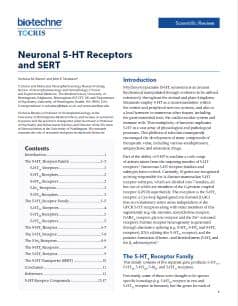5-HT7 Receptors
Serotonin 5-HT7 receptors are located primarily in the thalamus, hypothalamus and hippocampus. The function of these receptors includes the regulation of circadian rhythms, thermoregulation, learning and memory and smooth muscle relaxation.
5-HT7 Receptor Agonists |
|
|---|---|
| Cat. No. | 产品名称/活性 |
| 1968 | AS 19 |
| Potent 5-HT7 agonist | |
5-HT7 Receptor Antagonists |
|
| Cat. No. | 产品名称/活性 |
| 5005 | DR 4485 hydrochloride |
| High affinity and selective 5-HT7 antagonist; orally bioavailable | |
| 0937 | Pimozide |
| High affinity 5-HT7 antagonist; also D2 antagonist | |
| 2726 | SB 258719 hydrochloride |
| Selective 5-HT7 antagonist | |
| 1612 | SB 269970 hydrochloride |
| Potent and selective 5-HT7 antagonist; brain penetrant | |
Other |
|
| Cat. No. | 产品名称/活性 |
| 0458 | 5-Carboxamidotryptamine maleate |
| Has high affinity for 5-ht5A and 5-HT7. Also 5-HT1 agonist | |
Serotonin 5-HT7 receptors are located primarily in the thalamus, hypothalamus and hippocampus. The function of these receptors includes the regulation of circadian rhythms, learning and memory and smooth muscle relaxation. The human 5-HT7 receptor gene has been localized to chromosome 10 (10q21-24).
External sources of pharmacological information for 5-HT7 Receptors :
Literature for 5-HT7 Receptors
Tocris offers the following scientific literature for 5-HT7 Receptors to showcase our products. We invite you to request* your copy today!
*Please note that Tocris will only send literature to established scientific business / institute addresses.
5-HT Receptors Scientific Review
Written by Nicholas M. Barnes and John F. Neumaier, this review summarizes the various serotonin receptor subtypes and their importance in mediating the role of serotonin in numerous physiological and pharmacological processes. Compounds available from Tocris are listed.
Depression Poster
Major depressive disorder is characterized by depressed mood and a loss of interest and/or pleasure. Updated in 2015 this poster highlights presynaptic and postsynaptic targets for the potential treatment of major depressive disorder, as well as outlining the pharmacology of currently approved antidepressant drugs.

